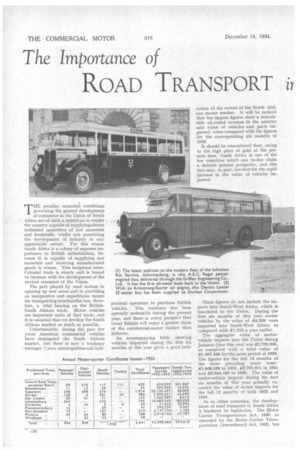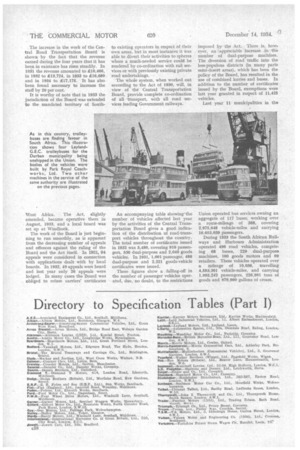The Importance of
Page 110

Page 111

Page 112

If you've noticed an error in this article please click here to report it so we can fix it.
ROAD TRANSPORT ir
SOUTH AFRICA
• THE peculiar economic conditions
governing the general development
of commerce in the Union of South Africa are of such a nature as to render the country capable of supplying almost unlimited quantities of raw materials and foodstuffs, whilst not permitting the development of industry to any appreciable extent. For this reason South Africa is a colony of supreme importance to British industrialists, because it is capable of supplying raw materials and receiving manufactured goods in return. This reciprocal interColonial trade is steady and is bound to increase with the development of the natural resources of the Union.
The part played by mad motors in opening up new areas and in providing an inexpensive and expeditious means for transporting merchandise has, therefore, a vital bearing on the BritishSouth African trade. Motor vehicles are important units of that trade, and it is essential that we develop the South African market as much as possible.
• Unfortunately, during the past few years American commercial vehicles have dominated the South African market, but there is now a tendency amongst Union municipalities and inde pendent operators to Purchase British vehicles. This tendency has been specially noticeable during the present year, and there is every prospect that Great Britain will enjoy a greater share of the commercial-motor market than hitherto.
An accompanying table I showing vehicles imported during the first six months of this year gives a good indi
cation of the extent of the South African motor market. It will be noticed that the import figures show a remarkable all-round increase in the number and value of vehicles and parts imported, when compared with the figures for the corresponding six months of 1933.
It should be remembered that, owing to the high price of gold at the present thee, South Africa is one of the few countries which can to-day claim a definite general .prosperity, and this fact may, in part, account for the rapid increase in the value of vehicles imported.
These figures do not include the imports into South-West Africa, which is mandated to the Union. During the first six months of this year motor vehicles 'to the value of £4,259 were imported into South-West Africa, as compared with £1,223 a year earlier.
The aggregate value :of 'motorvehicle imports into the Union during January-June this year was £2,733,335, as compared with a total value of £1,307,468 for-the same period of 1933. The figures for the full 12 months of the three preceding years were : £1,668,539 in 1932, £2,707,611 in 1931 and £3,044,183 in 1930. The value of motor-vehicle imports during the first six months of this' year actually exceeded the value of motor imports for the full 12 months of both 1932 and 1931.
As in other countries, the development of road transport in South Africa is hindered by legislation. The Motor Carrier Transportation Act, 1930, as amended by the Motor Carrier Transportation (Amendment) Act, 1932, has as its object the regulation of road traffic and the elimination of wasteful and uneconomic competition.
The Act defines certain proclaimed areas and routes over which it is not lawful for an' operator to carry persons and goods, whether for reward or in the course of his business or trade, without a certificate. There are certain exceptions to this section and for which a form of exeMption may be obtained.
All certificates authorizing the operation of buses or lorries over proclaimed areas or routes are obtainable from the special authority set up under the Act for the regulation and co-ordination of road transport (passenger and goods) with rail services or existing road services. This authority is the Central
Road Transportation 13oard, consisting of a chairman and two members, whilst a local transport board has been appointed for each of the proclaimed areas, the headquarters of which are at Bloemfontein, Capetown, Durban, East London, Johannesburg, Kimberley, Pietermaritzburg, Port Elizabeth, Pretoria and Windhoek (South-West Africa).
In the proclaimed areas the roadmotor services are used merely as
feeders to the railways. It may be wondered that such a method of control should find favour with the business and travelling community. We must not forget, however, that the Government administers practically the whole of the failway systems in the Union, including those operating in South-West Africa and Swaziland.
A great deal of money has been spent, by the State on the development of rail services, and the ratepayers, no doubt, prefer to restrict the extension of road transport, which threatens to thrive at the expense of the railways.
The total number of vehicles registered in the Union last year was 204,652, as compared with 193,902 in 1932. Of the total number registered in 1933, 1.093 were buses and 17,766 were lorries, vans, etc., as compared with 1,171 and 16,723 respectively in 1932. There were more new vehicles registered last year than in the previous year, 1,938 buses, lorries, vans, etc., being licensed in 1933, as compared with 1,368 in 1932. Last year 60 per cent. of all buses and 40 per cent, of all lorries were insured.
The number of vehicles registered at the end of last year in the mandated territory of South-West Africa is givers as 1,643 cars, 835 lorries, 124 motorcycles and one tractor. The increase in the work of the Central Road Transportation Board is shown by the fact that the revenue earned during the four years that it has been in existence has risen steadily. In 1931 the revenue amounted to £10,466, in 1932 to £13,724, in 1933 to £16,680 and in 1934 to £17,175. It has also been found necessary to increase the staff by 20 per cent.
It is worthy of note that in 1933 the jurisdictiOn of the Board was extended to the mandated territory of South
West Africa. The Act, slightly amended, became operative there in August, 1933, and a local board was set up at Windhoek.
The work of the Board is just beginning to run smoothly, as is apparent from the decreasing number of appeals and offences against• the ruling of the Board and the Act itself. In 1931, 94 appeals were considered in connection with applications dealt with by local boards. In 1932, 49 appeals were heard and last year only 26 appeals were lodged. In many cases the Board was obliged to refuse carriers' certificates to existing operators in respect of their own areas, but in most instances it was able to divert their activities to spheres where a .much-needed service could be rendered by co-ordination with rail services or with previously existing private road undertakings.
'The whole system, when worked out according to the Act of 1930, will, in view of the Central Transportation Board, provide complete co-ordination of all transport, with all road services feeding Government railways.
An accompanying table showing'the number of vehicles affected last year by the activities of the Central Transportation Board gives a good indication of the distribution of road-transport vehicles throughout the country. The total number of certificates issued in 1932 was 3,480, covering 910 passengers, 530 dual-purpose and 2,040 goods vehicles. In 1931, 1,001 passenger, 488 dual-purpose and 2,221 goods-vehicle certificates were issued.
These figures show a falling-off in the number of passenger vehicles operated, due,no doubt, to the restrictions imposed by the Act. There is, however, an lappreciable increase in the number of dual-purpose machines. The diversion of road traffic into the less-populous districts (in many parts seini-desert areas), which has been the policy of the Board, has resulted in the use of combined lorries and buses. In addition to the number of certificates issued by the Board, exemptions were last year granted in respect of 11,425 vehicles.
Last year 11 municipalities in the Union operated bus services owning an aggregate of 117 buses, working over a route-mileage of 388, covering 2,975,648 vehicle-miles and carrying 16,653,039 passengers.
During 1933 the South African Railways and Harbours Administration operated 496 road vehicles, comprising 68 buses, 229 dual-purpose machines, 100 goods motors and 99 retailers. These vehicles operated over a mileage of 10,036, travelling 4,583,301 vehicle-miles, and carrying 1,993,242 passengers, 226,991 tons of goods and 979,960 gallons of cream.




































































































































































